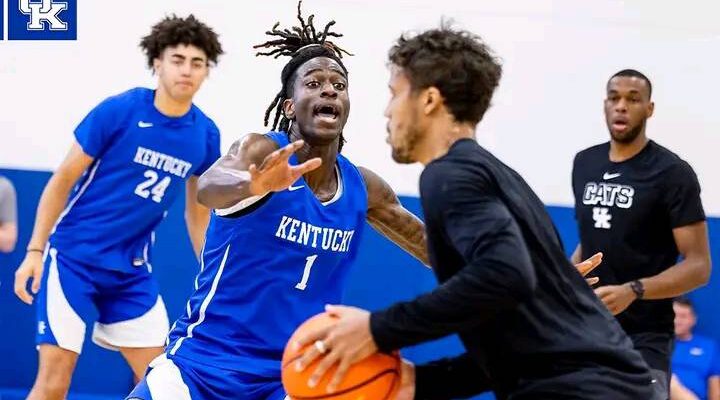Chaos in the Lineup? — What Practice Clips Tell Us About the Starting Five
In the modern sports landscape, the gap between what coaches intend to keep behind closed doors and what fans get to see has never been thinner. Thanks to the ubiquity of smartphones, social media, and increasingly transparent team communication, practice sessions—once strictly private affairs—have become arenas for public scrutiny. Clips from these sessions leak or are deliberately released, providing a raw, unfiltered look at the dynamics within a team’s starting five. But what do these practice clips really tell us? Who’s rising to the occasion, and who’s slipping through the cracks? And most intriguingly, what might coaches prefer to keep hidden?
Let’s break down the subtle (and not-so-subtle) messages embedded in practice footage, and how they might predict the stability—or chaos—of a team’s lineup.
Unlike game-day performances, practice sessions strip away the glamor and stakes, revealing players’ raw skills, conditioning, mental focus, and even their emotional state. Coaches often tailor practice to isolate weaknesses, test new strategies, or assess bench depth, but these moments also unintentionally spotlight player confidence and chemistry.
Why does this matter? Because coaches craft their starting lineup based on what they see day-in, day-out—not just on highlight reels. When practice clips surface, they can expose cracks in the expected rotation or affirm the readiness of less heralded players eager to make their mark.
1. Hustle and Energy Levels
One of the clearest indicators of a player vying for a starting role is the energy they bring to practice. In leaked clips, the hustle—quick footwork, relentless defense, diving for loose balls—stands out. Players who appear sluggish or distracted signal red flags to coaching staff.
For instance, when a forward who typically plays limited minutes suddenly dominates drills and pushes the tempo, it suggests an internal battle for more minutes. Watching a guard repeatedly take and make contested shots during scrimmages points to increased confidence and readiness to handle pressure.
2. Chemistry with Teammates
Practice footage often captures spontaneous pick-and-roll plays, fast breaks, and passing sequences without the structured setups of a real game. When the starting five clicks in these moments, it’s a sign of growing cohesion.
Players who communicate well, set screens effectively, and anticipate each other’s moves suggest a fluid lineup. Conversely, visible frustration, missed passes, or a lack of eye contact can indicate tension or unfamiliarity that might lead to lineup changes.
3. Command of the Playbook
Practice clips can reveal which players have internalized the coach’s system. Players who call out plays, direct teammates, and execute sets crisply show leadership qualities that could earn them starting roles or more playing time.
On the other hand, those who hesitate, make wrong cuts, or miss rotations may be on the hot seat. Coaches often look for players who elevate others and demonstrate basketball IQ, especially in practice when the stakes are lower but the details matter.
1. Lack of Effort or Focus
One of the most telling indicators from practice clips is a player’s level of engagement. Slowed feet, drifting off the play, or missing assignments may hint at physical fatigue, mental burnout, or even a lack of motivation. For veterans, this might suggest injury recovery or dissatisfaction with their role. For younger players, it could be nerves or confidence issues.
In some cases, subtle head shaking or sighing after mistakes captured in clips highlight internal frustration, which can signal a player struggling to maintain their place in the rotation.
2. Missed Fundamentals
Practice is about sharpening the basics. Players who repeatedly miss layups, fail to box out, or miss defensive rotations in clips raise red flags about their readiness to handle starting roles. These errors might be overlooked in game footage due to play complexity, but practice drills leave little room for error.
Players who don’t make adjustments after mistakes can lose trust from coaches, as practice is the prime opportunity for growth.
3. Communication Breakdowns
Practice footage can expose communication issues that disrupt the team’s rhythm. Players not calling out screens, missing switches, or standing out of position often reveal deeper problems with teamwork or understanding of schemes.
In some cases, a player’s body language—folded arms, avoidance of eye contact—may also suggest a breakdown in team chemistry, which could influence lineup decisions.
Coaches often prefer practice clips to remain private for several reasons:
- Tactical Secrecy: Revealing set plays or defensive schemes in practice can give opponents a preview of game plans.
- Morale Management: Public exposure of player mistakes or visible frustrations can undermine confidence and create locker-room tension.
- Control Over Narrative: Coaches want to control how the team’s progress and challenges are communicated to the media and fans.
Yet, despite these concerns, leaks happen. Sometimes coaches strategically release clips highlighting strong performances to build hype or reward hard-working players. Other times, footage escapes unintentionally, providing fans and analysts with an unvarnished look at the squad.
Team A: The Unexpected Starter Emerges
Mid-season, clips surfaced showing a backup shooting guard consistently outperforming the incumbent starter in 1-on-1 drills and scrimmages. His increased shot-making and defensive intensity led to whispers among fans—and ultimately, a starting role when the coach decided to shake up the lineup.
This example shows how practice clips can foreshadow changes long before official announcements, especially when a player demonstrates undeniable readiness.
Team B: Chemistry Concerns Lead to Lineup Shuffle
Practice videos revealed frequent miscommunications between two key starters during defensive drills. The clips showed missed switches and silent frustration, leading to speculation that one of the players might be moved to the bench to restore harmony.
Such footage offers a rare glimpse into internal issues that rarely show up in game statistics but can critically affect team performance.
Practice footage is more than a snapshot of individual effort. It captures the evolving story of a team—the push and pull of roles, the jockeying for position, and the silent battles behind the scenes. These clips often highlight:
- Leadership Battles: Who takes charge in practice often translates to leadership on the court.
- Fitness and Health Status: Players showing signs of fatigue or injury in drills may be limited on game day.
- Adaptability: How quickly players adjust to new tactics or teammates during practice can determine how fluid the starting five remains throughout the season.
For coaches, balancing this chaotic mix is a constant challenge. Practice clips, by shedding light on these elements, provide fans and analysts with a window into the team’s heartbeat—sometimes chaotic, sometimes harmonious.
The growing availability of practice footage offers a fascinating new layer of insight into basketball lineups. While game-day performances remain the ultimate test, what we see in practice often foreshadows who is ascending or declining within the team.
The hustle, communication, and execution shown in these clips can tell us who’s ready to take on bigger roles—and who might be slipping. Meanwhile, coaches grapple with managing what is revealed, knowing that every mistake or spark of brilliance could reshape the narrative around their starting five.
So next time you see a practice clip, look closely. Beneath the sweat and drills lies a story of ambition, struggle, and sometimes chaos—a story that could redefine the season’s starting lineup.



